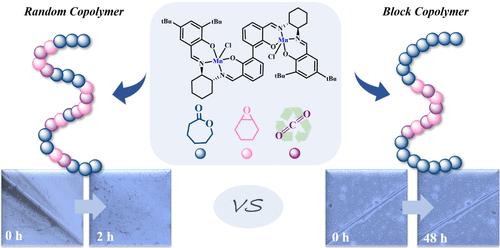聚(酯-共碳酸酯)的序列设计:可降解自修复共聚物的一个独特例子
IF 5.2
1区 化学
Q1 POLYMER SCIENCE
引用次数: 0
摘要
可降解和自愈聚合物被认为是下一代材料,因为它们既可以解决寿命终结问题,又可以解决合成材料的长期寿命问题。本研究以商品单体ε-己内酯(ε-CL)、环氧环己烯(CHO)和CO2为原料,设计了一系列集可降解性和自愈性于一体的脂肪族聚酯-聚碳酸酯共聚物。这些共聚物是在低CO2压力下由双核salen-Mn催化剂催化随机共聚合成的,在聚ε-己内酯(PCL)链上形成随机分布的碳酸盐单元。通过调节反应条件,制备了组分可控、微观结构可控的高摩尔质量共聚物。与相应的三嵌段共聚物不同,无规共聚物在环境甚至恶劣条件下都具有自主自愈能力,无需任何外部干预。无规共聚物在自愈方面的优异表现归因于纳米结构域的链间扩散和重建。这种序列调节方法可以作为设计和合成其他自愈共聚物的通用策略。本文章由计算机程序翻译,如有差异,请以英文原文为准。

Sequence Design of Poly(ester-co-carbonate): A Unique Example of Degradable Self-Healing Copolymers
Degradable and self-healing polymers are considered next-generation materials since they can tackle both the end-of-life issues and the long-standing longevity of synthetic materials. Here, we design a series of aliphatic polyester-polycarbonate copolymers combining degradability and self-healability using commodity monomers comprising ε-caprolactone (ε-CL), cyclohexene oxide (CHO), and CO2. These copolymers are synthesized by random copolymerization catalyzed by a dinuclear salen-Mn catalyst under low CO2 pressure, affording randomly distributed carbonate units on a poly(ε-caprolactone) (PCL) chain. High molar mass copolymers with controllable components and microstructures are obtained by regulating the reaction conditions. Different from corresponding triblock copolymers, the random copolymers exhibit autonomous self-healing capability under ambient or even harsh conditions without any external intervention. The outperformance of random copolymers in self-healing is ascribed to the interchain diffusion and reconstruction of nanodomains. This sequence regulation method may serve as a general facile strategy for the design and synthesis of other self-healing copolymers.
求助全文
通过发布文献求助,成功后即可免费获取论文全文。
去求助
来源期刊

Macromolecules
工程技术-高分子科学
CiteScore
9.30
自引率
16.40%
发文量
942
审稿时长
2 months
期刊介绍:
Macromolecules publishes original, fundamental, and impactful research on all aspects of polymer science. Topics of interest include synthesis (e.g., controlled polymerizations, polymerization catalysis, post polymerization modification, new monomer structures and polymer architectures, and polymerization mechanisms/kinetics analysis); phase behavior, thermodynamics, dynamic, and ordering/disordering phenomena (e.g., self-assembly, gelation, crystallization, solution/melt/solid-state characteristics); structure and properties (e.g., mechanical and rheological properties, surface/interfacial characteristics, electronic and transport properties); new state of the art characterization (e.g., spectroscopy, scattering, microscopy, rheology), simulation (e.g., Monte Carlo, molecular dynamics, multi-scale/coarse-grained modeling), and theoretical methods. Renewable/sustainable polymers, polymer networks, responsive polymers, electro-, magneto- and opto-active macromolecules, inorganic polymers, charge-transporting polymers (ion-containing, semiconducting, and conducting), nanostructured polymers, and polymer composites are also of interest. Typical papers published in Macromolecules showcase important and innovative concepts, experimental methods/observations, and theoretical/computational approaches that demonstrate a fundamental advance in the understanding of polymers.
 求助内容:
求助内容: 应助结果提醒方式:
应助结果提醒方式:


